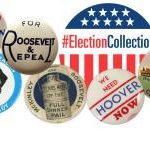The purpose of this lesson is to have students learn about each presidential election and presidential terms. Students will understand how various events in history shaped campaigns. Why elections were won and lost. What accomplishments and disappointments each president experienced. Each election and presidential term served had its own mark on history. The presentation to the class is the order of the elections starting with Washington’s first election and proceeding forward. The lesson plan was created to engage students in the election process and create interest in the coming presidential election.
Constituting America’s 90 Day Study of The Intrigue of Presidential Elections and Their Constitutional Impact is a resource guide for students. This study supplies many of the important facts and figures of each presidential campaign. There are also intriguing facts, stories, and information about the person, campaign, time in office and after the presidency.
Election: The Road to the White House (Secondary)
During an election, civic energy reaches a fever pitch. The vote is one of the citizen’s most powerful tools, and advocating for a candidate, a set of ideas, or a platform is the right of every citizen. The President of the United States is often called the most powerful person in the world, so with every presidential election, the stakes are high. This unit is designed to teach students about presidential elections. It is not a collection of facts, diagrams, and explanations of processes. It is an interactive, project-based unit that invites the student to fully engage in the process of an election while also informing students about how elections work. It is our hope that this unit helps cultivate the sorts of informed and engaged citizens that are so essential to our democracy.
Election 2020: Politics, Covid-19 and the Economy
The state of the economy during the presidential election season has a significant impact on not just the approval rating of the incumbent president at the time, but also has an impact on the policies in which presidential candidates run on. Additionally, the state of the economy also influences who will come out to vote in that year. This year, 2020, it is just one of many factors that may affect voter turnout but the economy may be underestimated. This exercise will encourage students to evaluate how other fluctuations in the economy may affect the ratings, policies, and decisions of the 2020 presidential candidates.
Presidential Elections And Their Constitutional Impact
Do presidential elections really change history? Can one person really make an impact? Let your students discover the answers to these questions and more by checking out this section of Constitution Archives from Constituting America. Each presidential election is described.
Election of 1800
In this activity, students will analyze the Electoral College tally for the presidential election of 1800 between John Adams and Thomas Jefferson.
Presidential Transitions
This lesson has students explore the challenges that incoming administrations face during presidential transitions. Students will hear from historians and from White House staff to learn about previous presidential transitions and how the administrations worked together. With this information, students will develop a list of best practices that can be used during these transitions.
The History of Contested Presidential Elections
This lesson looks at the contested presidential elections occurring in 1800, 1824, 1876 and 2000. Using C-SPAN video clips, students will identify how each election was resolved and the consequences of these elections. They will apply this knowledge by describing similarities and differences between these examples and determining what lessons can be learned from these elections.
Election: The Road to the White House (Elementary)
This unit is designed to teach students about presidential elections. It is not a collection of facts, diagrams, and explanations of processes. It is an interactive, project-based unit that invites the student to fully engage in the process of an election while also informing students about how elections work. It is our hope that this unit helps cultivate the sorts of informed and engaged citizens that are so essential to our democracy.
The Constitution in Action – Political Parties and Presidential Electors: The Election of 1800
History is the chronicle of choices made by actors/agents/protagonists in specific contexts. This simulation places students in the Early Republic and asks them to engage in the politics of those times. Acting as either Federalists or Republicans, they will be asked to develop strategies for electing their party’s standard bearer as president, using the Constitution’s complex system of presidential electors to their advantage.
Presidential Campaign Memorabilia on DocsTeach

This page includes a variety of primary sources in the form of artifacts, photographs, documents, and more; as well as additional online resources. Themes highlight political memorabilia from presidential campaigns from the 1850s through the 1990s. Items come from the holdings of the Presidential Libraries of the National Archives.